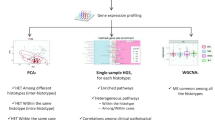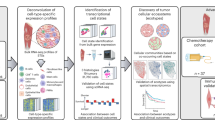Abstract
Sarcomas are heterogeneous and aggressive mesenchymal tumors. Histological grading has so far been the best predictor for metastasis-free survival, but it has several limitations, such as moderate reproducibility and poor prognostic value for some histological types. To improve patient grading, we performed genomic and expression profiling in a training set of 183 sarcomas and established a prognostic gene expression signature, complexity index in sarcomas (CINSARC), composed of 67 genes related to mitosis and chromosome management. In a multivariate analysis, CINSARC predicts metastasis outcome in the training set and in an independent 127 sarcomas validation set. It is superior to the Fédération Francaise des Centres de Lutte Contre le Cancer grading system in determining metastatic outcome for sarcoma patients. Furthermore, it also predicts outcome for gastrointestinal stromal tumors (GISTs), breast carcinomas and lymphomas. Application of the signature will permit more selective use of adjuvant therapies for people with sarcomas, leading to decreased iatrogenic morbidity and improved outcomes for such individuals.
This is a preview of subscription content, access via your institution
Access options
Subscribe to this journal
Receive 12 print issues and online access
$209.00 per year
only $17.42 per issue
Buy this article
- Purchase on Springer Link
- Instant access to full article PDF
Prices may be subject to local taxes which are calculated during checkout




Similar content being viewed by others
Accession codes
References
Fletcher, C.D.M., Unni, K.K. & Mertens, F. Pathology and genetics of tumors of soft tissue and bone. in World Health Organization Classification of Tumors (Lyon, IARC Press, 2002).
Weitz, J., Antonescu, C.R. & Brennan, M.F. Localized extremity soft tissue sarcoma: improved knowledge with unchanged survival over time. J. Clin. Oncol. 21, 2719–2725 (2003).
Zagars, G.K. et al. Prognostic factors for patients with localized soft-tissue sarcoma treated with conservation surgery and radiation therapy: an analysis of 225 patients. Cancer 97, 2530–2543 (2003).
Trojani, M. et al. Soft-tissue sarcomas of adults; study of pathological prognostic variables and definition of a histopathological grading system. Int. J. Cancer 33, 37–42 (1984).
Guillou, L. et al. Comparative study of the National Cancer Institute and French Federation of Cancer Centers Sarcoma Group grading systems in a population of 410 adult patients with soft tissue sarcoma. J. Clin. Oncol. 15, 350–362 (1997).
Coindre, J.M. et al. Predictive value of grade for metastasis development in the main histologic types of adult soft tissue sarcomas: a study of 1240 patients from the French Federation of Cancer Centers Sarcoma Group. Cancer 91, 1914–1926 (2001).
Idbaih, A. et al. Myxoid malignant fibrous histiocytoma and pleomorphic liposarcoma share very similar genomic imbalances. Lab. Invest. 85, 176–181 (2005).
Chibon, F. et al. The use of clustering software for the classification of comparative genomic hybridization data. An analysis of 109 malignant fibrous histiocytomas. Cancer Genet. Cytogenet. 141, 75–78 (2003).
Derré, J. et al. Leiomyosarcomas and most malignant fibrous histiocytomas share very similar comparative genomic hybridization imbalances: an analysis of a series of 27 leiomyosarcomas. Lab. Invest. 81, 211–215 (2001).
Chibon, F. et al. A subgroup of malignant fibrous histiocytomas is associated with genetic changes similar to those of well-differentiated liposarcomas. Cancer Genet. Cytogenet. 139, 24–29 (2002).
Coindre, J.M. et al. Most malignant fibrous histiocytomas developed in the retroperitoneum are dedifferentiated liposarcomas: a review of 25 cases initially diagnosed as malignant fibrous histiocytoma. Mod. Pathol. 16, 256–262 (2003).
Nielsen, T.O. et al. Molecular characterisation of soft tissue tumours: a gene expression study. Lancet 359, 1301–1307 (2002).
Baird, K. et al. Gene expression profiling of human sarcomas: insights into sarcoma biology. Cancer Res. 65, 9226–9235 (2005).
Fritz, B. et al. Microarray-based copy number and expression profiling in dedifferentiated and pleomorphic liposarcoma. Cancer Res. 62, 2993–2998 (2002).
Matushansky, I. et al. A developmental model of sarcomagenesis defines a differentiation-based classification for liposarcomas. Am. J. Pathol. 172, 1069–1080 (2008).
Segal, N.H. et al. Classification and subtype prediction of adult soft tissue sarcoma by functional genomics. Am. J. Pathol. 163, 691–700 (2003).
Lee, Y.F. et al. Molecular classification of synovial sarcomas, leiomyosarcomas and malignant fibrous histiocytomas by gene expression profiling. Br. J. Cancer 88, 510–515 (2003).
Nakayama, R. et al. Gene expression analysis of soft tissue sarcomas: characterization and reclassification of malignant fibrous histiocytoma. Mod. Pathol. 20, 749–759 (2007).
Singer, S. et al. Gene expression profiling of liposarcoma identifies distinct biological types/subtypes and potential therapeutic targets in well-differentiated and dedifferentiated liposarcoma. Cancer Res. 67, 6626–6636 (2007).
Lee, Y.F. et al. A gene expression signature associated with metastatic outcome in human leiomyosarcomas. Cancer Res. 64, 7201–7204 (2004).
Francis, P. et al. Diagnostic and prognostic gene expression signatures in 177 soft tissue sarcomas: hypoxia-induced transcription profile signifies metastatic potential. BMC Genomics 8, 73 (2007).
Carter, S.L., Eklund, A.C., Kohane, I.S., Harris, L.N. & Szallasi, Z. A signature of chromosomal instability inferred from gene expression profiles predicts clinical outcome in multiple human cancers. Nat. Genet. 38, 1043–1048 (2006).
Yamaguchi, U. et al. Distinct gene expression-defined classes of gastrointestinal stromal tumor. J. Clin. Oncol. 26, 4100–4108 (2008).
van 't Veer, L.J. et al. Gene expression profiling predicts clinical outcome of breast cancer. Nature 415, 530–536 (2002).
van de Vijver, M.J. et al. A gene-expression signature as a predictor of survival in breast cancer. N. Engl. J. Med. 347, 1999–2009 (2002).
Lenz, G. et al. Stromal gene signatures in large-B-cell lymphomas. N. Engl. J. Med. 359, 2313–2323 (2008).
Broders, A.C., Hargrave, R. & Meyerding, H.W. Pathologic features of soft tissue fibrosarcoma with special reference to the grading of its malignancy. Surg. Gynecol. Obstet. 69, 267–280 (1939).
Russell, W.O. et al. A clinical and pathological staging system for soft tissue sarcomas. Cancer 40, 1562–1570 (1977).
Markhede, G., Angervall, L. & Stener, B. A multivariate analysis of the prognosis after surgical treatment of malignant soft-tissue tumors. Cancer 49, 1721–1733 (1982).
Costa, J., Wesley, R.A., Glatstein, E. & Rosenberg, S.A. The grading of soft tissue sarcomas. Results of a clinicohistopathologic correlation in a series of 163 cases. Cancer 53, 530–541 (1984).
Sotiriou, C. et al. Gene expression profiling in breast cancer: understanding the molecular basis of histologic grade to improve prognosis. J. Natl. Cancer Inst. 98, 262–272 (2006).
Sotiriou, C. & Pusztai, L. Gene-expression signatures in breast cancer. N. Engl. J. Med. 360, 790–800 (2009).
Desmedt, C. & Sotiriou, C. Proliferation: the most prominent predictor of clinical outcome in breast cancer. Cell Cycle 5, 2198–2202 (2006).
Fidler, I.J. The pathogenesis of cancer metastasis: the 'seed and soil' hypothesis revisited. Nat. Rev. Cancer 3, 453–458 (2003).
Stafford, L.J., Vaidya, K.S. & Welch, D.R. Metastasis suppressors genes in cancer. Int. J. Biochem. Cell Biol. 40, 874–891 (2008).
Sarcoma Meta-analysis Collaboration. Adjuvant chemotherapy for localised resectable soft-tissue sarcoma of adults: meta-analysis of individual data. Lancet 350, 1647–1654 (1997).
Frustaci, S. et al. Adjuvant chemotherapy for adult soft tissue sarcomas of the extremities and girdles: results of the Italian randomized cooperative trial. J. Clin. Oncol. 19, 1238–1247 (2001).
Pervaiz, N. et al. A systematic meta-analysis of randomized controlled trials of adjuvant chemotherapy for localized resectable soft-tissue sarcoma. Cancer 113, 573–581 (2008).
Vincent-Salomon, A. et al. Identification of typical medullary breast carcinoma as a genomic sub-group of basal-like carcinomas, a heterogeneous new molecular entity. Breast Cancer Res. 9, R24 (2007).
La Rosa, P. et al. VAMP: visualization and analysis of array-CGH, transcriptome and other molecular profiles. Bioinformatics 22, 2066–2073 (2006).
Wu, Z. et al. A model based background adjustment for oligonucleotide expression arrays. J. Am. Stat. Assoc. 99, 909–917 (2004).
R Development Core Team. R: A language and environment for statistical computing. <http://www.R-project.org> (2010).
Acknowledgements
This work was supported by grants from the French Institut National du Cancer, the French Projets Hospitaliers de Recherche Clinique program, the European Connective Tissue Cancer Network, the Curie Institute, the Bergonie Cancer Institute and l'INSERM. The construction of the human BAC array was supported by grants from the Carte d'Identité des Tumeurs program of the French Ligue Nationale Contre le Cancer. We are grateful to members of the French Sarcoma Group for providing tumor samples : Y.-M. Robin, X. Leroy, X. Saster-Garau, B. Marquès, M-C. Château, J-P. Ghnassia and F. Mishelany, J-B. Courrège, V. Dapremont and C. Ferreira. We would like to thank R. Maki and R. Iggo for critical reading of the manuscript. We thank R. Cook for English editing.
Author information
Authors and Affiliations
Contributions
F. Collin, L.G., P.T., D.V.-R., A.L.C., B.B., S.B., A.L., J.-Y.B. and J.-M.C. supplied tumor tissues, did the central pathology review and collected the clinical follow-up data. F. Chibon supervised the laboratory experiments. P.L., G.P. and F. Chibon performed laboratory experiments. F.T. and C.L. developed the statistical software. A.d.R. and A.K. applied the centroid method. V.B. performed survival analysis. F. Chibon, S.S., A.d.R. and A.A. analyzed the data. F. Chibon, J.-M.C. and A.A. designed the study. F. Chibon, J.-M.C. and A.A. wrote the report. All investigators reviewed the final report.
Corresponding author
Ethics declarations
Competing interests
The authors declare no competing financial interests.
Supplementary information
Supplementary Text and Figures
Supplementary Figures 1 and 2 and Supplementary Tables 1–4 (PDF 370 kb)
Rights and permissions
About this article
Cite this article
Chibon, F., Lagarde, P., Salas, S. et al. Validated prediction of clinical outcome in sarcomas and multiple types of cancer on the basis of a gene expression signature related to genome complexity. Nat Med 16, 781–787 (2010). https://doi.org/10.1038/nm.2174
Received:
Accepted:
Published:
Issue Date:
DOI: https://doi.org/10.1038/nm.2174
This article is cited by
-
Deciphering the correlation between metabolic activity through 18F-FDG-PET/CT and immune landscape in soft-tissue sarcomas: an insight from the NEOSARCOMICS study
Biomarker Research (2024)
-
Sarcoma cell-specific radiation sensitization by titanate scrolled nanosheets: insights from physicochemical analysis and transcriptomic profiling
Scientific Reports (2024)
-
Genome-wide CRISPR/Cas9 library screening identified ATM signaling network genes as critical drivers for resistance to ATR inhibition in soft-tissue sarcomas: synthetic lethality and therapeutic implications
Experimental Hematology & Oncology (2023)
-
A pan-sarcoma landscape of telomeric content shows that alterations in RAD51B and GID4 are associated with higher telomeric content
npj Genomic Medicine (2023)
-
Technical development and validation of a clinically applicable microenvironment classifier as a biomarker of tumour hypoxia for soft tissue sarcoma
British Journal of Cancer (2023)



